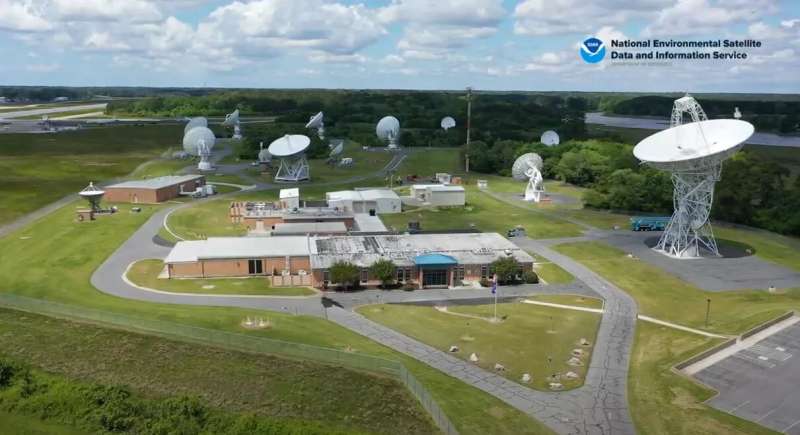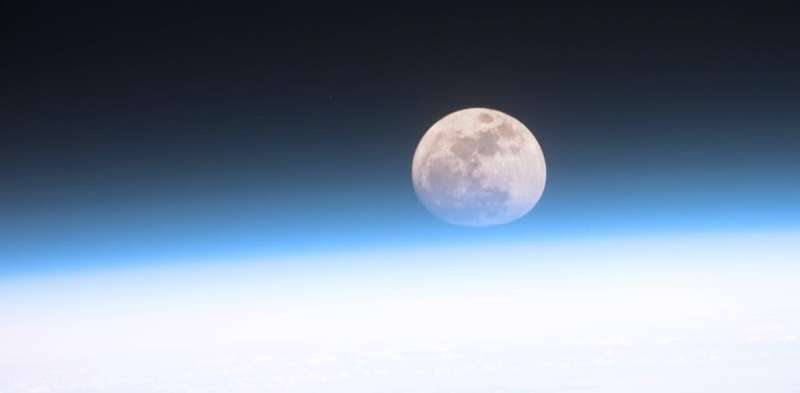
Copernical Team
NASA's NuSTAR Makes Illuminating Discoveries With 'Nuisance' Light
 For almost 10 years, NASA's NuSTAR (Nuclear Spectroscopic Telescope Array) X-ray space observatory has been studying some of the highest-energy objects in the universe, such as colliding dead stars and enormous black holes feasting on hot gas. During that time, scientists have had to deal with stray light leaking in through the sides of the observatory, which can interfere with observations much
For almost 10 years, NASA's NuSTAR (Nuclear Spectroscopic Telescope Array) X-ray space observatory has been studying some of the highest-energy objects in the universe, such as colliding dead stars and enormous black holes feasting on hot gas. During that time, scientists have had to deal with stray light leaking in through the sides of the observatory, which can interfere with observations much What's happening in the depths of distant worlds?
 The physics and chemistry that take place deep inside our planet are fundamental to the existence of life as we know it. But what forces are at work in the interiors of distant worlds, and how do these conditions affect their potential for habitability?
New work led by Carnegie's Earth and Planets Laboratory uses lab-based mimicry to reveal a new crystal structure that has major implicatio
The physics and chemistry that take place deep inside our planet are fundamental to the existence of life as we know it. But what forces are at work in the interiors of distant worlds, and how do these conditions affect their potential for habitability?
New work led by Carnegie's Earth and Planets Laboratory uses lab-based mimicry to reveal a new crystal structure that has major implicatio New astrobiology research predicts life 'as we don't know it'
 The search for alien life has been restricted to using life on Earth as the reference, essentially looking for "life as we know it" beyond Earth. For astrobiologists looking for life on other planets, there are simply no tools for predicting the features of "life as we don't know it."
In new research published in the Proceedings of the National Academy of Sciences (PNAS), a team of scienti
The search for alien life has been restricted to using life on Earth as the reference, essentially looking for "life as we know it" beyond Earth. For astrobiologists looking for life on other planets, there are simply no tools for predicting the features of "life as we don't know it."
In new research published in the Proceedings of the National Academy of Sciences (PNAS), a team of scienti Sols 3401-3402: Sand, Boulders and Ridges, Oh My
 Curiosity has been picking her way through sand, sharp boulders and ridges to find a way up onto the Greenheugh pediment. We briefly explored the pediment more than 600 sols ago, before resuming our traverse over the Mount Sharp group sedimentary rocks that we have been driving over since ~sol 750.
The science team is excited to drive up onto and investigate the very different looking rock
Curiosity has been picking her way through sand, sharp boulders and ridges to find a way up onto the Greenheugh pediment. We briefly explored the pediment more than 600 sols ago, before resuming our traverse over the Mount Sharp group sedimentary rocks that we have been driving over since ~sol 750.
The science team is excited to drive up onto and investigate the very different looking rock NASA Announces Launch Options for 2022 Student Launch Competition
 NASA's 2022 Student Launch rocketry challenge will provide both in-person and virtual opportunities for the competition's culminating event. The in-person option will include a two-day event, with hardware checks Friday, April 22, and launch day Saturday, April 23, in Huntsville, Alabama. If rain is a factor April 23, a makeup day is scheduled for Sunday, April 24.
Alternatively, Launch Di
NASA's 2022 Student Launch rocketry challenge will provide both in-person and virtual opportunities for the competition's culminating event. The in-person option will include a two-day event, with hardware checks Friday, April 22, and launch day Saturday, April 23, in Huntsville, Alabama. If rain is a factor April 23, a makeup day is scheduled for Sunday, April 24.
Alternatively, Launch Di Atlas V rocket launches new NOAA weather satellite
 NASA launched the latest in an advanced series of weather satellites, the GOES-T, from Florida on Tuesday to improve weather forecasting over the Pacific and western United States.
United Launch Alliance's Atlas V lifted off as planned into a mostly sunny sky at 4:38 p.m. EST from Complex 41 at Cape Canaveral Space Force Station.
Meteorologists around the world are looking forward to
NASA launched the latest in an advanced series of weather satellites, the GOES-T, from Florida on Tuesday to improve weather forecasting over the Pacific and western United States.
United Launch Alliance's Atlas V lifted off as planned into a mostly sunny sky at 4:38 p.m. EST from Complex 41 at Cape Canaveral Space Force Station.
Meteorologists around the world are looking forward to NASA to launch sophisticated weather satellite
 NASA plans to launch the latest in an advanced series of weather satellites, the GOES-T, from Florida on Tuesday to improve weather forecasting over the Pacific and western United States.
United Launch Alliance's Atlas V rocket is prepared for liftoff during a two-hour window starting at 4:38 p.m. EST from Complex-41 at Cape Canaveral Space Force Station.
Meteorologists around th
NASA plans to launch the latest in an advanced series of weather satellites, the GOES-T, from Florida on Tuesday to improve weather forecasting over the Pacific and western United States.
United Launch Alliance's Atlas V rocket is prepared for liftoff during a two-hour window starting at 4:38 p.m. EST from Complex-41 at Cape Canaveral Space Force Station.
Meteorologists around th Russian-European Mars rover 'very unlikely' to launch this year
 A Russian-European mission to land a rover on Mars is "very unlikely" to launch this year due to sanctions over Moscow's invasion of Ukraine, the European Space Agency said.
The launch of the Rosalind Franklin rover, whose mission is to drill into Martian soil to seek out signs of life, was originally planned for 2020 but postponed due to Covid-19 and technical delays.
In January the ESA
A Russian-European mission to land a rover on Mars is "very unlikely" to launch this year due to sanctions over Moscow's invasion of Ukraine, the European Space Agency said.
The launch of the Rosalind Franklin rover, whose mission is to drill into Martian soil to seek out signs of life, was originally planned for 2020 but postponed due to Covid-19 and technical delays.
In January the ESA How the Wallops Command and Data Acquisition Station prepares for GOES-T satellite launch

With the upcoming launch of NOAA's new GOES-T satellite, staff at ground stations such as NOAA's Wallops Command and Data Acquisition Station (WCDAS) located at NASA's Wallops Flight Facility are in full swing preparing for the event.
Although Wallops launches smaller rockets as well as research aircraft, unmanned aerial systems, and high-altitude balloons, the facility also supports NOAA's satellite tracking and commanding capabilities.
We spoke with Gregory Johnson, a GOES Ground System Engineer, and Jesse Speidel, Chief of Operations, about just what goes on at Wallops before and after a satellite launch.
First however, they explained that ground stations, like Wallops, are basically radio stations that communicate with satellites from the ground by transmitting and receiving radio waves via large parabolic antennas. Wallops tracks many satellites orbiting Earth this way, as well as deep space satellites that monitor solar activity. The ground stations can send commands to the satellites as well as receive data from them that they then send to be processed.
A rocket is going to crash into the moon: Accidental experiment on the physics of impacts in space

On March 4, 2022, a lonely, spent rocket booster will smack into the surface of the moon at nearly 6,000 mph. Once the dust has settled, NASA's Lunar Reconnaissance Orbiter will move into position to get an up-close view of the smoldering crater and hopefully shed some light on the mysterious physics of planetary impacts.
As a planetary scientist who studies the moon, I view this unplanned impact as an exciting opportunity. The moon has been a steadfast witness to solar system history, its heavily cratered surface recording innumerable collisions over the last 4 billion years. However, scientists rarely get a glimpse of the projectiles—usually asteroids or comets—that form these craters. Without knowing the specifics of what created a crater, there is only so much scientists can learn by studying one.
